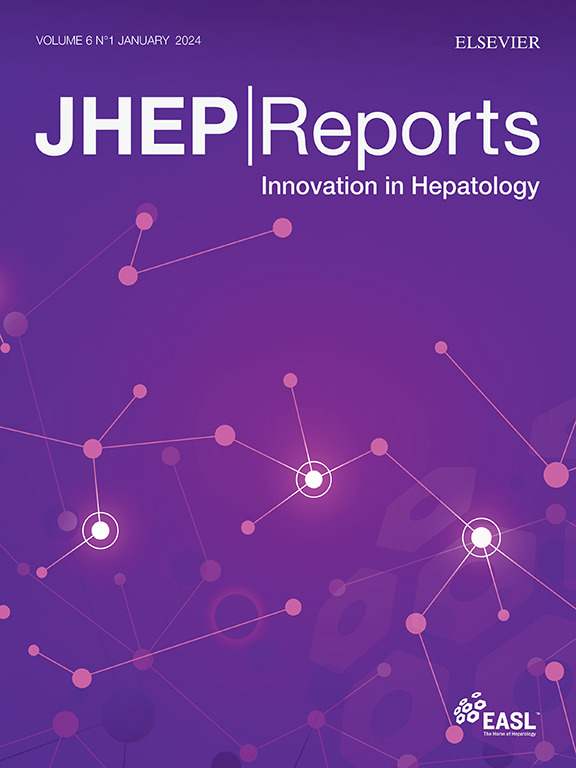atezolizumab/bevacizumab治疗进展后晚期HCC的二线治疗模式和结果。
IF 9.5
1区 医学
Q1 GASTROENTEROLOGY & HEPATOLOGY
引用次数: 0
摘要
背景与目的:Atezolizumab/bevacizumab (A/B)目前是晚期肝细胞癌(HCC)的标准一线治疗方案,但最佳二线治疗方案尚不清楚。我们评估了现实世界的治疗模式和结果,以调查与进展后生存(PPS)相关的因素。方法:在这项多中心、国际、回顾性研究中,我们研究了一线A/B治疗进展的晚期HCC患者的临床特征和预后。PPS的主要终点被定义为从A/B的首次x线片进展到死亡的时间。结果:共有406例患者在一线A/B治疗进展后存活,其中45.3% (n = 184)接受了最佳支持治疗(BST), 54.7% (n = 222)继续积极全身治疗。在第二条线上,155名患者接受酪氨酸激酶抑制剂(TKIs)治疗,45名患者接受基于免疫检查点抑制剂(IO)的方案治疗,3名患者数据缺失。整个队列的中位生存期(mPPS)为6.0个月(95% CI 5.2-7.2)。多因素Cox回归分析,门静脉肿瘤血栓缺失,ECOG与BST (9.7 vs 2.6个月;HR 0.41, p 0.001)。在二线环境中,TKIs治疗的患者与IO治疗的患者相比,mPPS的数值较短(8.4个月vs 14.9个月;HR 1.37, p = 0.256)。结论:即使在调整基线疾病特征后,A/B进展后继续积极治疗与更好的生存率独立相关。以IO为基础的mPPS治疗超过一年,表明进展后继续IO治疗可能保留益处。TKI和IO方案的精确排序值得进一步研究。影响和启示:目前缺乏一线atezolizumab +贝伐单抗治疗后进展的晚期肝细胞癌患者二线治疗方案的1级数据,因为所有二线批准都是在一线索拉非尼时代建立的。我们的研究旨在通过调查二线治疗环境中真实患者的结果来填补一些知识空白。这项研究的结果表明,与接受最佳支持治疗的患者相比,持续积极治疗的患者的进展后生存率有所提高,并且结合酪氨酸激酶抑制剂和免疫治疗药物的药物方案是有效的。在我们等待随机对照试验成熟数据的同时,这些结果可以帮助临床医生为阿特唑单抗加贝伐单抗治疗后进展的患者提供可能的治疗选择。本文章由计算机程序翻译,如有差异,请以英文原文为准。

Second-line treatment patterns and outcomes in advanced HCC after progression on atezolizumab/bevacizumab
Background & Aims
Atezolizumab/bevacizumab (A/B) is now a standard first-line treatment for advanced hepatocellular carcinoma (HCC), but the optimal second-line regimen is not known. We evaluated real-world treatment patterns and outcomes to investigate factors associated with post-progression survival (PPS).
Methods
In this multicenter, international, retrospective study, we examined clinical characteristics and outcomes of patients with advanced HCC who progressed on first-line A/B. The primary outcome of PPS was defined as time from first radiographic progression on A/B to death.
Results
A total of 406 patients alive after progression on first-line A/B were included in the final analysis, of whom 45.3% (n = 184) received best supportive treatment (BST) and 54.7% (n = 222) continued active systemic treatment. In the second line, 155 patients were treated with tyrosine kinase inhibitors (TKIs), 45 with immune checkpoint inhibitor (IO)-based regimens, and 3 had missing data. Median PPS of the whole cohort (mPPS) was 6.0 months (95% CI 5.2-7.2). On multivariate Cox regression analysis, absence of portal vein tumor thrombus, ECOG <2, and continued active treatment were predictors of better PPS. mPPS was significantly longer for patients who continued active treatment vs. BST (9.7 vs. 2.6 months; HR 0.41, p <0.001). In the second-line setting, patients treated with TKIs had a numerically shorter mPPS compared to those treated with IO (8.4 vs. 14.9 months; HR 1.37, p = 0.256).
Conclusions
Continuation of active therapy after A/B progression was independently associated with better survival even after adjusting for baseline disease characteristics. mPPS with IO-based therapy exceeded a year, suggesting that IO continuation post-progression may retain benefit. The precise sequencing of TKI and IO regimens warrants further investigation.
Impact and implications:
There is currently a lack of level 1 data on second-line treatment options for patients with advanced hepatocellular carcinoma who progress after frontline atezolizumab plus bevacizumab, as all second-line approvals were established during the frontline sorafenib era. Our study aims to fill in some of the knowledge gap by investigating real-world patient outcomes in the second-line treatment setting. Findings from this study show that patients who continued active treatment had improved post-progression survival compared to those who received best supportive care, and medication regimens incorporating tyrosine kinase inhibitors as well as immunotherapy agents were active. These results can help inform clinicians of possible treatment options for patients who progress after frontline atezolizumab plus bevacizumab while we await maturing data from randomized-controlled trials.
求助全文
通过发布文献求助,成功后即可免费获取论文全文。
去求助
来源期刊

JHEP Reports
GASTROENTEROLOGY & HEPATOLOGY-
CiteScore
12.40
自引率
2.40%
发文量
161
审稿时长
36 days
期刊介绍:
JHEP Reports is an open access journal that is affiliated with the European Association for the Study of the Liver (EASL). It serves as a companion journal to the highly respected Journal of Hepatology.
The primary objective of JHEP Reports is to publish original papers and reviews that contribute to the advancement of knowledge in the field of liver diseases. The journal covers a wide range of topics, including basic, translational, and clinical research. It also focuses on global issues in hepatology, with particular emphasis on areas such as clinical trials, novel diagnostics, precision medicine and therapeutics, cancer research, cellular and molecular studies, artificial intelligence, microbiome research, epidemiology, and cutting-edge technologies.
In summary, JHEP Reports is dedicated to promoting scientific discoveries and innovations in liver diseases through the publication of high-quality research papers and reviews covering various aspects of hepatology.
 求助内容:
求助内容: 应助结果提醒方式:
应助结果提醒方式:


